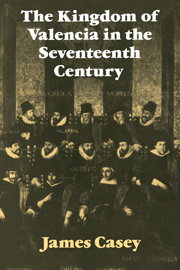Book contents
- Frontmatter
- Contents
- List of illustrations
- Preface
- Abbreviations
- A note on measures
- Map of the kingdom of Valencia
- Introduction
- 1 A long depopulation
- 2 Rich and poor
- 3 The decline of agriculture
- 4 Paying their way in the world
- 5 The seigneurial reaction
- 6 The bankruptcy of the senyors
- 7 The eclipse of the Popular Estate
- 8 The rule of the judges
- 9 Outlaws and rebels
- 10 The loyal kingdom
- Conclusion
- Appendix 1 Fluctuations in the tithes 1500–1700
- Appendix 2 The exploitation of a Valencian senyoriu: the marquesate of Lombay 1559–1700
- Appendix 3 Approaches to a budget for the Dukes of Gandía 1605–99
- Appendix 4 List of viceroys 1598–1700
- Bibliographical note
- Index
7 - The eclipse of the Popular Estate
Published online by Cambridge University Press: 03 May 2010
- Frontmatter
- Contents
- List of illustrations
- Preface
- Abbreviations
- A note on measures
- Map of the kingdom of Valencia
- Introduction
- 1 A long depopulation
- 2 Rich and poor
- 3 The decline of agriculture
- 4 Paying their way in the world
- 5 The seigneurial reaction
- 6 The bankruptcy of the senyors
- 7 The eclipse of the Popular Estate
- 8 The rule of the judges
- 9 Outlaws and rebels
- 10 The loyal kingdom
- Conclusion
- Appendix 1 Fluctuations in the tithes 1500–1700
- Appendix 2 The exploitation of a Valencian senyoriu: the marquesate of Lombay 1559–1700
- Appendix 3 Approaches to a budget for the Dukes of Gandía 1605–99
- Appendix 4 List of viceroys 1598–1700
- Bibliographical note
- Index
Summary
The Third Estate of seventeenth-century Valencia consisted of four cities (Valencia, Alicante, Orihuela and Játiva), and some 29 ‘royal towns’ with representation in the Cortes. These varied in size from the capital with its 12,327 households to the remote mountain community of Castelfabib with a mere 154. Within this spectrum Castellón de la Plana believed itself to be ‘very big and populous, having 1,500 households’. In fact, the average size of the nine politically most important towns, excluding the capital, works out at just under 1,300, with the median being 1,350. In social composition they ranged from the metropolis with its ‘1,500 houses (at very least) belonging to the lords and great men of the kingdom’ (according to the exaggerated claim of Antoine de Lalaing) and its churches and convents which (thought Escolano) ‘must certainly occupy a third of the superficial area’, down to the overgrown village of Villarreal, few of whose 459 families ‘can get by without working for a living’ and the seaport of Villajoyosa, most of whose 350 families ‘are working people, occupied in tilling the soil or fishing’. The royal towns were not, then, a homogeneous social group – any more, indeed, than the senyors. But they formed a clearly defined political and juridical category – the ‘voice of the people’ as expressed through the Third Estate.
Compared with the multiplicity of works on rural society, good urban studies are something of a rarity in early modern European history.
- Type
- Chapter
- Information
- The Kingdom of Valencia in the Seventeenth Century , pp. 154 - 178Publisher: Cambridge University PressPrint publication year: 1979

